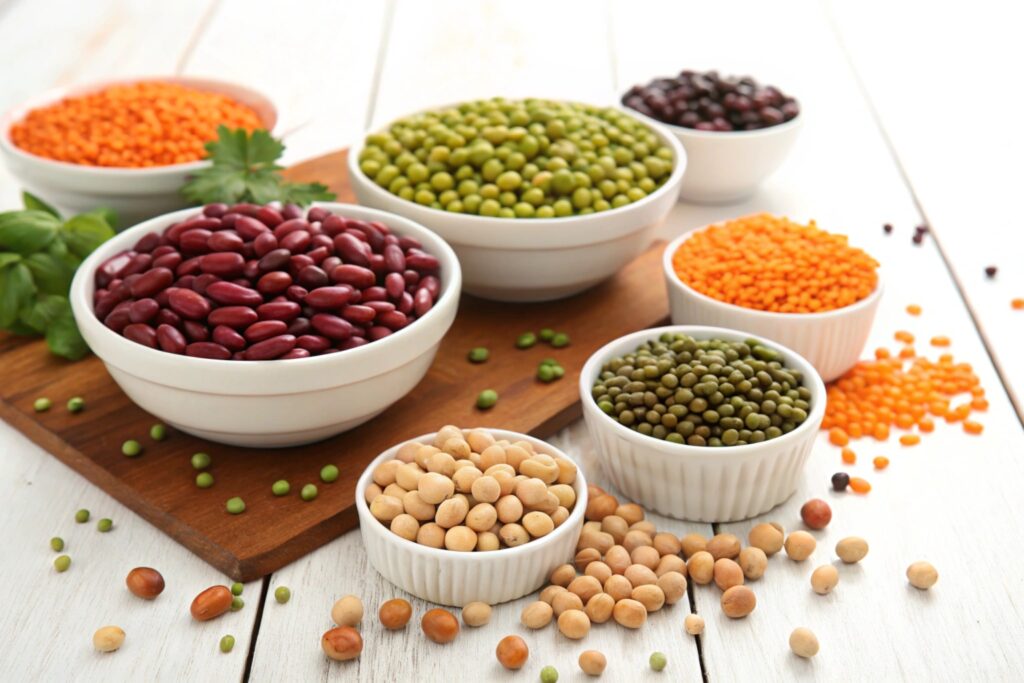Soup is one of the most versatile and comforting meals, enjoyed by cultures worldwide for centuries. High-protein soups, in particular, have gained popularity as a wholesome way to support a healthy lifestyle. Whether you’re looking for a cozy meal on a cold night, a post-workout recovery dish, or an easy weeknight dinner, high-protein soups can meet your needs. These soups are not only packed with nutrients but are also incredibly satisfying, making them perfect for a balanced meal. In this guide, we’ll explore the benefits, types, key ingredients, and tips to create the perfect high-protein soups for any occasion.
Benefits of High-Protein Soups
High-protein soups are more than just a comforting meal on a cold night. They provide a plethora of nutritional and lifestyle benefits that make them a staple in many diets. Here’s why these soups deserve a place in your weekly meal prep rotation:
Nutritional Advantages
Protein is an essential macronutrient for maintaining muscle mass, repairing tissues, and supporting overall health. High-protein soups often combine lean protein sources like chicken breast, ground turkey, or black beans with nutrient-dense vegetables, creating a well-rounded meal.
Soups like lentil kale soup or Super Greens and Beans Soup are packed with fiber and vitamins, delivering a balanced meal that supports immunity and digestion. Ingredients such as cannellini beans, sweet potato, and vibrant broccoli offer a profile rich with vitamins and minerals, including immunity-supporting vitamin C, potassium, and antioxidants. These components contribute to overall well-being, helping your body fight off illness and maintain energy levels throughout the day.
Weight Management
High-protein soups are an excellent choice for those aiming to lose or maintain weight. Protein promotes satiety, reducing the likelihood of overeating. A warm bowl of soup filled with legumes, lean meats, and aromatic vegetables can curb hunger effectively, making it a nutrient-dense yet low-calorie meal option.
Consider soups like creamy tomato soup made with Greek yogurt for a creamy texture without the added calories or fat. Adding ingredients like quinoa or whole-grain bread alongside your soup can create a complete and satisfying meal that’s still low in calories. The high fiber content in many protein-rich ingredients also aids digestion and prevents snacking between meals.
Muscle Recovery and Growth
For individuals focused on fitness, high-protein soups play a vital role in muscle recovery and growth. Protein helps repair muscle fibers that are broken down during exercise, while also supporting the growth of new muscle tissue. Soups like chicken soups or protein-packed taco soup provide the essential amino acids needed to repair and strengthen muscles post-workout.
Ingredients like bone broth or protein per cup additions such as nutritional yeast or legumes can further enhance recovery. Bone broth, for example, is not only a great source of protein but also contains collagen, which helps maintain joint health—a crucial aspect for active individuals.
Types of High-Protein Soup Recipes
High-protein soups cater to various tastes and dietary needs. Below are some categories of protein-rich soups and their standout qualities:
Chicken-Based Soups
Chicken-based soups are a classic choice for a reason. Options like chicken noodle soup or comforting roast chicken soup combine the savory flavors of chicken broth with protein-packed chicken breast or thighs. These soups are often paired with aromatic vegetables like celery, carrots, and onions, along with flavorful spices like garlic powder and black pepper to create a warming, nutrient-rich dish.
For a modern twist, consider family-friendly Thai-style noodle soup. This variation incorporates lean chicken breast, coconut milk, and vibrant spices like ginger and lemongrass for a tangy yet hearty meal. Another option is creamy chicken and vegetable soup, where light coconut milk or Greek yogurt replaces traditional cream to boost protein while maintaining a rich texture.
Beef-Based Soups
Beef-based soups bring a heartiness that’s perfect for cozy weather meals. Using lean ground beef, you can create delicious recipes like beef and vegetable soup or taco soup. These soups often feature nutrient-dense ingredients like black beans, corn, and tomatoes, offering a balanced meal that’s both filling and flavorful.
Another popular option is beef barley soup. While the barley adds carbohydrates for energy, the lean beef provides a significant protein boost. Enhance these recipes with warm spices such as cumin or chili powder for extra depth of flavor.
Turkey-Based Soups
Turkey-based soups are an excellent way to use ground turkey or leftover roast turkey in a healthy and satisfying meal. Recipes like turkey chili or turkey vegetable soup combine lean protein with hearty vegetables, making them perfect for meal prep or weeknight dinners.
For a unique spin, try a turkey and quinoa soup. The quinoa adds additional protein and texture, while ingredients like sweet potato, kale, and garlic cloves create a nutrient-rich, savory flavor profile. Add a dash of balsamic vinegar or lemon juice for a zesty finish.
Seafood Soups
Seafood soups are a light yet protein-packed option for those who love ocean flavors. Soups like shrimp bisque, clam chowder, or soup with salmon provide omega-3 fatty acids along with ample protein. Seafood soups often pair well with aromatic vegetables such as leeks, garlic, and onions, alongside creamy coconut milk or broth-based bases.
Asian-inspired seafood soups, like miso soup with tofu and shrimp or spicy fish soup, add bold flavors with the use of soy sauce, fresh ginger, and chili flakes. These dishes are not only delicious but also nutrient-dense, supporting cardiovascular and brain health.
Vegetarian Soups
Vegetarian soups rely on plant-based proteins like beans, lentils, and quinoa to deliver satisfying meals. Black bean soup and white bean soup are rich in protein and fiber, making them hearty enough to stand alone as a main course.
Adding grains like farro or bulgur to vegetable soups can elevate them into a balanced meal. Consider a Mediterranean-inspired soup featuring chickpeas, spinach, and a hint of lemon juice for a light but filling option.
Vegan Soups
Vegan soups go one step further, offering protein-rich options without any animal products. Lentil kale soup or butternut squash soup enriched with nutritional yeast and coconut milk are both satisfying and full of flavor. Quinoa and black beans are versatile additions that can enhance the protein content of any vegan soup.
For a cheesy touch, sprinkle vegan parmesan cheese or nutritional yeast over the soup before serving. Pair these soups with a slice of whole-grain bread for a complete meal.
Key Ingredients for High Protein Content
High-protein soups rely on specific ingredients to achieve their protein-rich status. Here are some key components:
Legumes and Beans

Black beans, cannellini beans, and lentils are affordable and versatile sources of plant-based protein. They work well in soups like taco soup or black bean soup, providing texture and heartiness.
Adding canned beans to vegetable soups is a quick and easy way to boost protein. Rinse them thoroughly to remove excess sodium and add them toward the end of cooking to maintain their shape and texture.
Lean Meats

Lean protein options such as chicken breast, ground turkey, and lean ground beef offer significant protein without excess fat. These ingredients are perfect for making family-friendly soups like Gingery Spring Soup. When using meat, ensure it’s cooked thoroughly before adding to soups to retain its juicy texture.
Seafood Varieties
Seafood, including salmon, shrimp, and white fish, adds a delicate yet rich flavor to soups. Options like soup with salmon or seafood chowders incorporate high protein per cup. Seafood is also an excellent source of iodine and omega-3 fatty acids, supporting thyroid function and cardiovascular health.
Dairy and Dairy Alternatives
Greek yogurt, cream cheese, and light coconut milk provide creaminess while boosting protein content. Using well-stirred coconut milk or dairy-free alternatives ensures a creamy texture without compromising dietary restrictions. Blend these ingredients with roasted vegetables for a velvety soup base.
Quinoa and Other Grains

Quinoa, brown rice, and wholemeal pasta add protein and carbohydrates, creating a complete meal. Soups like vegetable broth-based quinoa soup are nutritious and filling. Experiment with other grains like farro or millet for a twist on traditional recipes.
How to Boost the Protein Content of Soups
If you’re looking to make your soups even more protein-rich, here are some strategies:
Adding Protein Powders
Unflavored protein powders can be mixed into soups without altering the taste. They’re ideal for liquid diets or when aiming to increase protein intake. Stir the powder in gradually to avoid clumping and ensure a smooth consistency.
Incorporating Nut Butters
Nut butters like almond or peanut butter can add richness and protein to soups, especially in recipes inspired by Asian flavors. A tablespoon or two can transform a simple broth into a creamy, satisfying dish.
Using Bone Broth
Bone broth vegetable soup or stock from roast dinner enhances both the flavor and protein content of soups. Bone broth is also rich in collagen, which supports joint health, skin elasticity, and overall gut health. It’s an excellent base for soups like chicken noodle or beef vegetable soup.
Tips for Cooking Perfect High-Protein Soups
Creating high-protein soups requires attention to detail. Follow these tips to ensure your soups are delicious and nutritious:
Selecting Fresh Ingredients
Using fresh vegetables, lean meats, and aromatic herbs like garlic cloves and fresh ginger ensures lots of flavor and optimal nutrition. Fresh ingredients enhance the soup’s texture and taste, making every bite enjoyable.
Proper Cooking Techniques
Cook soups on medium-high heat to medium-low heat, depending on the recipe. Simmering allows flavors to meld together while preserving the nutrients in the ingredients. For creamy soups, blending the base and seasoning with salt as needed can create the perfect texture.
Flavor Pairing Suggestions
Pair ingredients like sweet potato and black beans with warm spices such as chili powder and cumin. Italian spices or Vietnamese spices can add a unique twist to your soups. Don’t be afraid to experiment with fresh spices to create lots of flavor.
Storage Guidelines for High-Protein Soups
Storing soups properly is key to maintaining their flavor and nutritional value. Follow these tips:
Refrigeration Tips
Store leftover soup in an airtight container to preserve freshness. Soups can typically be refrigerated for up to 3 days. Ensure the soup is fully cooled before sealing the container to prevent condensation and spoilage.
Freezing Tips
For longer storage, freeze soups in freezer-safe containers. Label each container with the date and type of soup for easy identification. Portioning soups before freezing makes reheating more convenient, especially for meal prep.
Reheating Methods
Reheat soups on medium heat, stirring occasionally. For creamy soups, add a splash of broth or light coconut milk to restore the texture. Avoid overheating, as it can cause proteins to break down and alter the soup’s consistency.
Conclusion
High-protein soups are versatile, nutritious, and perfect for any meal. From creamy tomato soup made with Greek yogurt to hearty vegetable soups packed with legumes, there’s a recipe for everyone. By incorporating lean proteins, fresh spices, and thoughtful cooking techniques, you can create comforting soups that satisfy both your taste buds and your nutritional needs. Embrace these soups as a staple in your meal prep rotation and enjoy their benefits for weight management, muscle recovery, and overall well-being.
Try pairing your soup with a cottage cheese flatbread for a balanced meal.
Check out the bok choy soup for another nutrient-packed soup recipe.


2 thoughts on “High Protein Soup”